Video isn’t one-size fits all for your inbound marketing funnel. Many companies make the mistake of thinking video is a magic bullet, that they only need one, or that it’s just a box they should check. Those same companies likely wind up wondering why video didn’t make much of a difference in their marketing efforts.
In order for video to be truly impactful for inbound marketing, your videos should be aligned with the specific aims you are seeking to achieve at each stage in the buying decision process, as well as your overall marketing strategy. Here is a breakdown of the four different types of videos you can use to nudge potential customers along, and tricks for making yours compelling.
What is Inbound Marketing?
As a quick primer, an inbound marketing strategy relies on specific tactics to attract customers. The idea is to ensure prospects come to you when they are shopping for something you offer. Classic inbound tactics consist of SEO, content marketing, paid search, email marketing, and social marketing.
In comparison, outbound marketing usually entails cold-calling and other lead prospecting tactics. You are the one approaching potential customers identified by your research, and not the other way around.
So, why do inbound marketing? When done well, it tends to be very efficient in terms of marketing spend, and highly targeted since your leads are self-selecting.
Also, people only encounter your brand or messaging when at an event, being entertained by content, or actively searching for what you offer. You’re not interrupting anyone’s day with inbound marketing. Rather, you’re providing value and solutions to potential customers.
1. Brand Awareness and Discovery
The top of the inbound marketing funnel is all about getting your brand out there. You need to make sure potential customers know you exist. Event sponsorship, brand partnerships, charitable work, and content marketing are all relevant here.
Video has proven to be very effective at generating brand awareness, especially because of the potential for getting a viral hit. Of course, going viral is a relatively rare phenomenon.
Adjust your goals according to the nature of your target persona, make more than one video, and define success for your specific video(s). Success might not mean going viral, but perhaps being shared broadly within a specific niche, or generating certain levels of engagement.
Brands that are doing a particularly good job with top of funnel brand awareness include Dollar Shave Club, Squatty Potty, Red Bull, and GoPro. Here’s our favorite:
As that video exemplifies, top of funnel content works well when it’s engaging and share-worthy. It has to really stand out from the crowd. People share content for really specific reasons, and working one (or more) of those factors into your video will help ensure its success.
2. Targeted Interest and Providing Value
Once someone is aware of your brand, you’ll want to make sure you stay top of mind for when they might be shopping for a product or service you offer. This stage is all about showing up in targeted search results for terms relevant to your product or brand. The idea is to deliver value-laden content for those who click through on those terms.
Video can help you rank for specific search terms when it’s setup on the page correctly. It helps because it gets visitors to stick around on the page longer, and adds rich metadata to the page. Both of these factors send strong signals back to search engines that the page contains relevant content for a given search term.
Targeting a Niche
For this type of content, the goal is to provide value to your customers that is a lot more industry or company-specific. The best option here is material that really speaks to your target customer personas. It’s more than ok to go really niche here – that will attract the most targeted leads.
For instance, Buzzfeed gets into highly specific topics, that seem like they should only resonate with a small subsection of the population. That’s exactly the point. That small subsection of the population that the content really speaks to consists of the people who are going to share those videos and engage with them the most. Don’t forget, all of those people have friends who they’ll share it with, too.
That Buzzfeed video has more than a million views. They took a relatively universal phenomenon (taking after one’s parents) and made it more specific.
Thought Leadership
Thought leadership is an excellent option for B2B companies who aren’t quite comfortable with such ephemeral and whimsical videos as the Buzzfeed example. TED Talks, in many ways the epitome of thought leadership, have been going in-depth on niche topics for years, with great success. For instance, this video on body language, which is really thorough and detailed, has over 9 million views:
The person speaking in it, Amy Cuddy, helped bolster her position as a thought leader on the subject by speaking at length about the importance of body language on camera. It’s doubtful she would have reached such a broad audience any other way.
People in your company are likely to be subject matter experts in a variety of topics. If you can map their expertise to your target customer personas, you’ll have some winning topics to cover.
3. Attract and Convert
Once someone knows your brand, and trusts that you are an expert in your domain, they are much more likely to come directly to your site to shop when they are looking for a product or service you offer. At this point, you want to increase the chances they’ll convert. Or, try to capture their contact information so you can follow up in the future.
The right type of content to use depends on the products or services you are offering. Still, some general rules do apply. The right videos will focus on the benefit to the consumer, rather than just showcasing the item’s best attributes.
When choosing what to show off about the product, service, or event, maintain focus on the three core attributes a buyer will care most about. It’s best to determine which those attributes are through surveys, feedback, or polls. If you’re guessing or relying on your instincts, you’ll likely miss the mark.
Product Videos
If your goal is just to drive conversions, placing video on the page is an excellent start. Video has been shown to dramatically increase conversion rates on product landing pages. Even if the product isn’t overly complex, such as a shoe, video has been shown to help.

Zappos is one of the classic cases people reference when they talk about video and conversions. In their testing, Zappos saw a 6-30% lift in conversions when they included video on a product page!
Lead Capture With Video
If your product has a longer sales cycle, and you’re looking to capture leads, use email gating for your videos, or custom post-play screens. Either option can help generate a list of targeted prospects for your products or services.
In that instance, your videos have to be particularly high value content. You’re asking someone to exchange personal information to view them, or will be doing so right after they’ve watched one.
Your content should engender trust, and make the reasons you’re asking for their contact information crystal clear. Think thought leadership, expert interviews, event reviews from speakers, or longer and more in-depth product videos.
4. Engage and Retain
Once you have acquired a customer, you need to retain and engage them in order to sustainably grow your business. For this stage, you might also want to consider targeting referrals to other potential customers as a goal.
On-going learning, product announcements, new feature releases, industry trends, or new ideas for using what they’ve already bought are all excellent ways to drive engagement through video. If possible, personalize the content you share with them to further cement the relationship.
Improve Over Time
Measure the efficacy of your videos at every stage of your marketing funnel. Otherwise, how will you know whether they are having the desired impact?
With SproutVideo, you can leverage powerful analytics and video engagement metrics. This data allows you to understand exactly how much an individual viewer is watching of your videos, and how they perform overall. With those stats, you can make tweaks to your content over time to improve conversion rates.
How are you implementing video in your inbound marketing strategy? Let us know in the comments below!
Ready to implement video in your inbound marketing strategy? Open a free 30 day trial today and get started right away.








